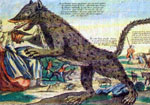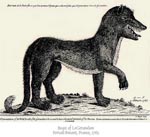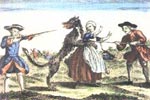
From about 1764 to 1767 the people of the former province of Gevaudan, which is modern day Lozere, near the Margeride Mountains in south central France, were terrorized by a massive wolf like creature which became known as La bête du Gevaudan, The Beast of Gevaudan. The creature was described as being relatively wolf like, about the size of a cow, with feet armed with razor sharp claws, reddish hair, a large head shaped like a greyhounds, small, straight ears, a wide chest, a back streaked with black and a large mouth which exposed very large fangs. It is thought that before the killing stopped the Beast of Gevaudan had killed between 60 to 100 men, women and children, as well as injuring more than 30.  The first known encounter with the Beast of Gevaudan took place in May or June of 1764 in the Mercoire forest near Langogne in the eastern part of Gevaudan, when a young woman tending to her herd of cattle suddenly noticed a gruesome beast charging at her. It is reported that her bulls were able to fend off the charging beast, keeping it at bay with their horns. The beast charged for a second time again being driven off by the bulls and their sharp horns. These cattle brave allowed the frightened woman enough time to escape with her life.
The first known encounter with the Beast of Gevaudan took place in May or June of 1764 in the Mercoire forest near Langogne in the eastern part of Gevaudan, when a young woman tending to her herd of cattle suddenly noticed a gruesome beast charging at her. It is reported that her bulls were able to fend off the charging beast, keeping it at bay with their horns. The beast charged for a second time again being driven off by the bulls and their sharp horns. These cattle brave allowed the frightened woman enough time to escape with her life.
In the months following this first attack terror gripped the region as the beast continued its onslaught, seemingly favoring easy prey like women, children and lone men tending live stock in secluded pastures. The creature’s reported method of killing was unusual for a predator, seemingly targeting the head of its victims and ignoring the usual areas targeted by predators, including the legs and throat. Victims that were not devoured completely or carried off were often found with their heads crushed or completely removed, not a normal characteristic of known predators attack methods, including wolves.
Due to the high number of attacks, some of which seemed to take please at almost the same time, people began to suspect that there may have been a pair of these beasts. In fact some reports did suggest that the creature was seen with another such animal, while others suggested that the beast was accompanied by its young. In some rare reported the beast was reportedly accompanied by a man, which lead to later speculations that the beast was actually trained to do these killings. As the Beast of Gevaudan continued its killing spree it began to take on more of a supernatural visage, guns seemed useless for even when the creature was shot it appeared unaffected.  In October 1764 two unnamed hunters reportedly spotted the beast and shot it from a distance of only 10 paces. Upon being shot the creature fell to the ground but immediately sprang to its feet again, a second shot was fired into the creature and again it fell to the ground. This time the creature rose slowly but managed to escape to a nearby wood. As it made its escape the hunters reportedly fired to more shots into the beast, each time falling to the ground only to rise again. Upon hearing of this report and seeing the actual blood trail which lead into the woods locals were sure that this time the creature was mortally wounded and that it would be found dead the next day. To their horror the following day, instead of finding the body of the beast, they found the body of several more victims of the beast, freshly slaughtered that day.
In October 1764 two unnamed hunters reportedly spotted the beast and shot it from a distance of only 10 paces. Upon being shot the creature fell to the ground but immediately sprang to its feet again, a second shot was fired into the creature and again it fell to the ground. This time the creature rose slowly but managed to escape to a nearby wood. As it made its escape the hunters reportedly fired to more shots into the beast, each time falling to the ground only to rise again. Upon hearing of this report and seeing the actual blood trail which lead into the woods locals were sure that this time the creature was mortally wounded and that it would be found dead the next day. To their horror the following day, instead of finding the body of the beast, they found the body of several more victims of the beast, freshly slaughtered that day.
The next month massive beats, also known as hunting parties, composted of every available peasant were organized by a Captain Duhamel, who led fifty seven of his soldiers, forty on foot and seventeen on horse back, on a massive hunt for the Beast of Gevaudan. The beast proved to be too much for the soldiers, escaping every time they appeared to have the beast cornered. The soldiers even went as far as to dress like women to lure the creature out of hiding with the prospect of an easy kill, however this and the rest of Captain Duhamel’s traps proved useless.
Soon a large reward was posted for the beast’s slaying, hunters from far and wide traveled to Gevaudan to join the soldiers which continued to look for the creature. This hunt went on for months, over one hundred wolves were slaughtered but the Beast of Gevaudan continued to elude everyone. Locals grew tired of these outside hunters eating their food, trampling through their fields and invading their homes. Tales of the Beast of Gevaudan eventually made there way to every corner of Europe, and even made its way to the ears of King Louis XV, who, after a brutal public attack by the beast on two young children, sent a Norman squire and hunter by the name of Denneval to the district.  In February of 1765 Denneval began tracking the beast with six of his best bloodhounds. He was soon joined by Jacques Denis, the sixteen year old son of a local farmer. Jacques explained his eagerness to destroy the beast stemmed from the death of his 20 year old sister at the hands of the beast, Jacques who witnessed the attack on his sister swore vengeance. The two became good friends and continued to hunt the beast together for months. In May of that year the beast, in one of its most daring attacks, went on a rampage at the great spring fair.
In February of 1765 Denneval began tracking the beast with six of his best bloodhounds. He was soon joined by Jacques Denis, the sixteen year old son of a local farmer. Jacques explained his eagerness to destroy the beast stemmed from the death of his 20 year old sister at the hands of the beast, Jacques who witnessed the attack on his sister swore vengeance. The two became good friends and continued to hunt the beast together for months. In May of that year the beast, in one of its most daring attacks, went on a rampage at the great spring fair.
During this attack the beast killed several people including a young lady by the name of Marguerite, a friend of Jacques Denis. Angered locals, led by Jacques, grabbed pitch forks along with any other weapons they could muster and unleashed their dogs on the still fresh sent of the beast. Soon the dogs lead Jacques straight to the beast, he attacked it violently with his bayonet, seemingly unfazed by Jacques’ attacks the beast leaped at the young man. It would have killed him too if it were not for the arrival of more hunters prompting the beast to flee. Shortly after the attack on Jacques, Denneval gave up his hunt for the beast.
Not long after Denneval’s departure the beast went on another rampage, reportedly killing a fourteen year old boy, a forty five year old woman and carrying off a small child. A furious king then gave his personal gun carrier, Antoine de Beauterne, the task of slaying the Beast of Gevaudan. Beauterne seemingly did little at first; he surveyed the area, drew some maps of the animal’s routes and carefully inspected the landscape. Then, on September 21st, he organized a hunting group comprised of forty local hunters and 12 dogs. Seemingly guided by his research of the beast and the terrain, de Beauterne had the men circle a ravine in the woods near the village of Pommier. As soon as the dogs were unleashed they started to bark like mad and the Beast emerged from the bushes to investigate.
Beauterne fired his gun hitting the creature in the right shoulder, the other hunters opened fire, one of their shots reportedly went right through the beast’s right eye and its skull. The creature fell to the ground dead, however as the men rejoiced the beast rose to its feet and charged de Beauterne. The hunters fired a second volley of bullets which ripped though the beast again; injured and bleeding it turned around and tried to escape before collapsing again, dead at last.
Upon examination its was determined the that Beast of Gevaudan was actually an enormous form of rare wolf measuring a little over 6 feet, weighting 143 pounds with a huge head and fangs over an inch long. For over a year after the beast’s death things remained calm, that is until the spring of 1767 when the beast apparently came back to life and started its massacres again. On June 19th of that year a local nobleman organized one of the largest hunting parties ever to track the creature, comprised of well over 300 hunters and beaters.  Jean Chastel, an acquaintance of Jacques Denis and his sister, joined the hunt, he brought along his gun loaded with blessed silver bullets on the off chance that rumors that the Beast of Gevaudan was actually a werewolf were true. He positioned himself in a prime location, opened his prayer book and waited for the beast. As he prayed there was a sudden rustling at the edge of the woods, as he watched the beast emerged from the tree line a few yards away from him. It stopped and looked at Chastel who raised his gun and fired two silver bullets in the beast, killing it instantly.
Jean Chastel, an acquaintance of Jacques Denis and his sister, joined the hunt, he brought along his gun loaded with blessed silver bullets on the off chance that rumors that the Beast of Gevaudan was actually a werewolf were true. He positioned himself in a prime location, opened his prayer book and waited for the beast. As he prayed there was a sudden rustling at the edge of the woods, as he watched the beast emerged from the tree line a few yards away from him. It stopped and looked at Chastel who raised his gun and fired two silver bullets in the beast, killing it instantly.
Just like the beast killed by Antoine de Beauterne this creature looked relatively like a wolf but was much bigger than any local wolves. The creature was soon gutted and the remains of a young girl were found inside. The Beast of Gevaudan was embalmed and taken from town to town so people could have a look at it, for a small fee of course. Sadly for modern science embalming techniques were not very good at the time and by the time the corpse reached the king it had begun to rot badly. The smell upset the king so badly the he ordered the body disposed of immediately. Reports vary on exactly what happened to the corpse at this point, some say it was burned while others say it was buried in an unknown location.
The remains of the Beast of Gevaudan were never recovered, sparking more than two centuries of speculation as to the real identity of the creature. In 1960, after studying a notary report prepared by two surgeons who had examined the beast’s corpse in the 1700s, a researcher determined that the creature’s teeth were very wolf like. Franz Jullien, a taxidermist at the National Museum of Natural History in Paris, discovered that a stuffed specimen similar to the creature shot by Jean Chastel had been kept in the museum’s collection from 1766 thru 1819. This stuffed specimen had apparently been successfully identified as a striped hyena, native to Northern Africa, the Middle East, Pakistan and western India.
Was the Beast of Gevaudan a hyena rather than a large wolf as originally determined? The idea was not new to Novelist Henri Pourrat and naturalist Gerard Menatory who had previously proposed the hyena hypothesis based on historical accounts. According to these accounts Antoine Chastel, Jean Chastel’s son, reportedly possessed a hyena in his menagerie, a seventeen century French term for keeping wild and exotic animals in human captivity. The discovery of this stuffed hyena, combined with accounts that the Chastels owned a pet hyena, led some investigators to suggest that the Chastels may have created the story of the Beast of Gevaudan in order to cover up rumors of one of them being a serial killer.
Others have pointed out that some accounts of the beast included the sighting of a man with the creature. This has lead these researchers to speculate that the Chastels may have trained their hyena and possibly hyenas to attack people and then let them loose on the countryside, only to later kill their own pets and be hailed as a hero. This is pure speculation of course as no one knows for sure just what these creatures may have been or why they suddenly came out of the darkness to attack and terrify a small French province for over 3 years.
The Evidence
A discovery by Franz Jullien, a taxidermist at the National Museum of National History in Paris, suggests that the Beast of Gevaudan may have been a stripped hyena. Franz discovered that the museum once owned a stuff specimen of the beast and had previously determined it to be a form of stripped hyena, though the body is long since gone and there remains no real way to determine if this report was correct.
The Sightings
In May or June of 1764 in the Mercoire forest near Langogne in the eastern part of Gevaudan a young woman tending to her herd of cattle suddenly noticed a gruesome beast charging at her.
In October 1764 two unnamed hunters reportedly spotted the beast and shot it from a distance of only 10 paces. Upon being shot the creature fell to the ground but immediately sprang to its feet again, a second shot was fired into the creature and again it fell to the ground. This time the creature rose slowly but managed to escape to a nearby wood.
On September 21st 1765, the king’s personal gun carrier, Antoine de Beauterne, organized a group comprised of forty local hunters and 12 dogs. Seemingly guided by his research of the beast and the terrain, de Beauterne had the men circle a ravine in the woods near the village of Pommier. As soon as the dogs were unleashed they started to bark like mad and the Beast sprang from the bushes. Beauterne fired, hitting the creature in the right shoulder, the other hunters opened fire, one shot going right through the beast’s right eye and its skull. The creature fell to the ground dead as the men rejoiced. Suddenly the beast rose to its feet and charged de Beauterne. The hunters fired a volley hitting the beast again; it turned around and tried to escape before collapsing again, dead at last.
On June 19th 1767, the beast apparently came back to life; Jean Chastel, an acquaintance of Jacques Denis and his sister, soon found the beast and killed it with two silver bullets, thus ending the killings.
The Stats– (Where applicable)
• Classification: Hybrid
• Size: Roughly 6 feet
• Weight: Roughly 150 points
• Diet: Cattle, live stock, men, women and children
• Location: The Gevaudan Provence of France
• Movement: Four legged walking
• Environment: Forested areas surrounding small villages
|